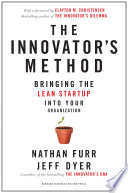

The Innovator's Method outlines a structured approach to innovation, breaking it down into a repeatable process. This process consists of four key stages: Understand, Observe, Ideate, and Validate. The authors emphasize the importance of understanding the problem space before jumping to solutions. By observing potential users and their behaviors, innovators can gather insights that inform the ideation process. This stage encourages brainstorming and the generation of multiple ideas without judgment. Finally, validation is crucial; it involves testing ideas with real users to gather feedback and refine solutions. This systematic approach helps teams avoid common pitfalls in the innovation process, such as making assumptions without evidence or rushing to implement ideas that haven't been thoroughly vetted.
Continue readingA cornerstone of The Innovator's Method is the emphasis on customer-centric innovation. The authors argue that successful innovations are rooted in a deep understanding of customer needs and pain points. By engaging with customers through interviews and observations, innovators can uncover insights that lead to more relevant and impactful solutions. This customer-centric approach not only helps in identifying what customers truly value but also fosters a sense of ownership among users, increasing the likelihood of adoption. The book provides practical techniques for conducting user research and emphasizes the importance of empathy in the innovation process.
Continue readingRapid prototyping is a key component of The Innovator's Method, allowing innovators to quickly translate ideas into tangible forms. The authors advocate for creating low-fidelity prototypes that can be tested and iterated upon rapidly. This approach minimizes the risks associated with developing fully-featured products without first validating the concept. By building prototypes, teams can gather feedback early in the development process, making it easier to pivot or refine ideas based on user input. The book outlines various prototyping techniques and emphasizes the importance of fostering a culture of experimentation within organizations to encourage innovation.
Continue readingThe mantra 'fail fast, learn faster' encapsulates a crucial mindset for innovators. The Innovator's Method encourages teams to embrace failure as an integral part of the innovation journey. By testing ideas quickly and learning from the outcomes—whether successful or not—teams can accelerate their learning and improve their solutions. This iterative process helps to reduce the fear of failure, which can stifle creativity and risk-taking. The authors provide examples of companies that have successfully adopted this mindset, demonstrating how a culture that values experimentation and learning can lead to breakthrough innovations.
Continue readingIn addition to product innovation, The Innovator's Method highlights the importance of business model innovation. The authors argue that even the most innovative products can fail if the underlying business model is flawed. By exploring different ways to capture value, innovators can create sustainable businesses around their solutions. The book discusses various business model frameworks and encourages teams to think critically about how their innovations will generate revenue and deliver value to customers. This focus on business model innovation ensures that teams are not only creating great products but also building viable businesses.
Continue readingThe Innovator's Method stresses the significance of cross-functional collaboration in driving innovation. The authors argue that diverse teams bring a variety of perspectives and expertise, which can lead to more creative solutions. By fostering an environment where different departments—such as marketing, engineering, and design—collaborate, organizations can leverage the strengths of each function. The book provides strategies for facilitating effective collaboration and communication among team members, highlighting that innovation is rarely the result of isolated efforts but rather a collective endeavor.
Continue readingFinally, The Innovator's Method addresses the importance of cultivating a mindset and culture that supports innovation. The authors argue that for innovation to thrive, organizations must create an environment where experimentation is encouraged, and employees feel empowered to share ideas. This involves leadership commitment to innovation, investing in training and resources, and recognizing and rewarding innovative efforts. The book outlines practical steps for leaders to foster a culture of innovation, emphasizing that a supportive environment can significantly enhance an organization's ability to innovate successfully.
Continue reading